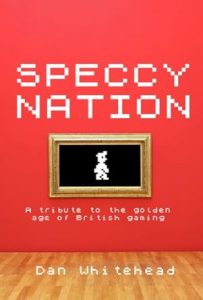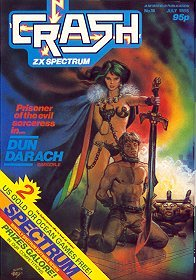Harnessing the Past to Build the Future: Inspiring a Nation of Coders
10 PRINT "Coding is Cool" 20 GOTO 10
 Scotland is experiencing a crisis of student enrolment numbers into Computer Science.
Scotland is experiencing a crisis of student enrolment numbers into Computer Science.
As a core skill central to our digital nation ambition it’s critical we explore how we might address and reverse this trend.
One key dimension to explore is Scotland’s deep history with programming, that many may not even be aware of.
Speccy Nation
In the misty early 1980s, as Scotland’s industrial heartlands hummed with change, a small, unassuming black box with rainbow stripes arrived in homes across Glasgow, Edinburgh, and beyond: the ZX Spectrum.
 Launched in 1982 by Sinclair Research, this affordable home computer, brainchild of English inventor Sir Clive Sinclair, found a special place in Scotland’s cultural and technological landscape. Dan Whitehead documented this nationwide boom of home computing, chronicling how it paved the way for a British revolution in tech skills, building a Speccy Nation.
Launched in 1982 by Sinclair Research, this affordable home computer, brainchild of English inventor Sir Clive Sinclair, found a special place in Scotland’s cultural and technological landscape. Dan Whitehead documented this nationwide boom of home computing, chronicling how it paved the way for a British revolution in tech skills, building a Speccy Nation.
Scotland even has a history with the ZX Spectrum, indeed one that is pivotal to the success of it’s flagship tech industry: Game development.
Abertay University showcased the history of how the Timex factory in Dundee manufactured the Spectrums, shared in this video, and as the BBC and Natwest describe this laid the foundations for an evolution that led to the Dundee region becoming a global powerhouse that produced entrepreneurs including Chris van der Kuyl, co-founder and chairman of 4J Studios famous for the global phenomenon Minecraft, and titles including Lemmings and Grand Theft Auto.
Scotland, with its proud tradition of engineering and innovation—think of James Watt and the steam engine—was primed for the microcomputer revolution. The ZX Spectrum, priced at £125 for the 16K model and £175 for the 48K, was a revelation for a nation where working-class families often struggled to afford luxuries. Its accessibility sparked a computing boom, particularly among Scotland’s youth, who saw it as a portal to creativity and opportunity.
Dundee – Scotland’s First Digital City
In Dundee, a city already known for jute, jam, and journalism, the Spectrum fueled a new industry: game development. Timex, a factory in Dundee, was Sinclair’s manufacturing hub for the ZX Spectrum in the UK. Workers on the assembly lines pieced together thousands of these machines, unaware they were building the foundation of a digital revolution.
By 1983, Timex’s Dundee plant was churning out Spectrums at a feverish pace, with Scotland becoming a quiet powerhouse behind the computer’s UK dominance.
The Spectrum’s influence went beyond production. In bedrooms and school computer clubs across Scotland, young coders hammered away at the machine’s rubber keys, crafting games and demos. The quirky, limited hardware—its 3.5 MHz processor and blocky graphics—demanded ingenuity.
Scottish developers like David Jones and Russell Kay, who later co-founded DMA Design in Dundee, cut their teeth on the Spectrum. DMA’s early titles, like ‘Menace’ (1988), bore the hallmarks of Spectrum-inspired creativity, paving the way for global hits like ‘Lemmings’ and, eventually, ‘Grand Theft Auto’. Dundee became a gaming hub, earning the nickname “Silicon Glen” as tech firms sprouted in the 1980s and 1990s.
In Glasgow, the Spectrum fostered a DIY ethos. Teenagers swapped cassette tapes loaded with games like ‘Manic Miner’ and ‘Jet Set Willy’, often pirated in schoolyards or bought from local shops like Boots.
Learning to Code
Coding magazines like ‘Your Sinclair’ and ‘Crash’ were devoured, teaching Scots to program in BASIC. In Edinburgh, universities and tech enthusiasts used the Spectrum to experiment with early networking and software, laying groundwork for Scotland’s tech ecosystem.
The Spectrum’s cultural impact lingered. Its chiptune music and pixelated aesthetic inspired Scottish artists and musicians, while its affordability democratized technology in a nation recovering from deindustrialization.
By the late 1980s, as newer machines like the Amiga and Atari ST emerged, the Spectrum’s reign waned, but its legacy in Scotland endured. From Dundee’s game studios to Glasgow’s hacker meetups, the ZX Spectrum didn’t just bring computing to the masses—it sparked a creative fire that helped shape Scotland’s modern tech identity.
From Code Club to CodeClan
So what is the modern equivalent, how can we replicate such an impactful phenomena and harness it to reverse the tide of declining Computer Science education in Scotland?
The Code Show is seeking to tap this nostalgia to do so. Literally, they have a bank of over 300 vintage machines including ZX Spectrums, BBC Micros and Commodore 64s, and travel the country setting these up in schools to inspire the children through exposing them to the history of the UK computing industry.
This sets the scene for the most important of initiatives: Coding Clubs. In Scotland there are organizations like Code Club Scotland, and as Mike Dailly, creator of Lemmings and Grand Theft Auto, shared in a tweet, these clubs provide the very first step that began his computing career. With schools challenged in terms of teaching resources these can bridge that gap.
What Next?
What of the technology, what is the modern day ZX Spectrum?
Key tools include Replit, an online coding environment where you can start coding instantly right from your browser, and with organizations like CodeClan enabling a transition into employment in the business world for software developers, it’s clear Scotland has most of the pieces to define an end-to-end computing learning and career journey for students.
The missing piece is the most important one – How do we inspire children to take their very first step into that career?




